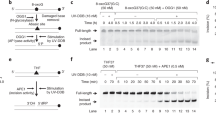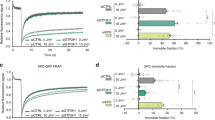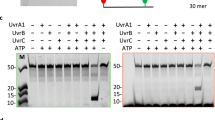Abstract
Nucleotide excision repair (NER) is used by all organisms to eliminate DNA lesions. We determined the structure of the Geobacillus stearothermophilus UvrA–UvrB complex, the damage-sensor in bacterial NER and a new structure of UvrA. We observe that the DNA binding surface of UvrA, previously found in an open shape that binds damaged DNA, also exists in a closed groove shape compatible with native DNA only. The sensor contains two UvrB molecules that flank the UvrA dimer along the predicted path for DNA, ~80 Å from the lesion. We show that the conserved signature domain II of UvrA mediates a nexus of contacts among UvrA, UvrB and DNA. Further, in our new structure of UvrA, this domain adopts an altered conformation while an adjacent nucleotide binding site is vacant. Our findings raise unanticipated questions about NER and also suggest a revised picture of its early stages.
This is a preview of subscription content, access via your institution
Access options
Subscribe to this journal
Receive 12 print issues and online access
$189.00 per year
only $15.75 per issue
Buy this article
- Purchase on Springer Link
- Instant access to full article PDF
Prices may be subject to local taxes which are calculated during checkout







Similar content being viewed by others
References
Jemal, A., Siegel, R., Xu, J. & Ward, E. Cancer statistics, 2010. CA Cancer J. Clin. 60, 277–300 (2010).
Sancar, A. & Reardon, J.T. Nucleotide excision repair in E. coli and man. Adv. Protein Chem. 69, 43–71 (2004).
Gillet, L.C. & Schärer, O.D. Molecular mechanisms of mammalian global genome nucleotide excision repair. Chem. Rev. 106, 253–276 (2006).
Schärer, O.D. Hot topics in DNA repair: the molecular basis for different disease states caused by mutations in TFIIH and XPG. DNA Repair (Amst.) 7, 339–344 (2008).
Truglio, J.J., Croteau, D.L., Van Houten, B. & Kisker, C. Prokaryotic nucleotide excision repair: the UvrABC system. Chem. Rev. 106, 233–252 (2006).
Orren, D.K. & Sancar, A. The (A)BC excinuclease of Escherichia coli has only the UvrB and UvrC subunits in the incision complex. Proc. Natl. Acad. Sci. USA 86, 5237–5241 (1989).
Jaciuk, M., Nowak, E., Skowronek, K., Tanska, A. & Nowotny, M. Structure of UvrA nucleotide excision repair protein in complex with modified DNA. Nat. Struct. Mol. Biol. 18, 191–197 (2011).
Truglio, J.J. et al. Structural basis for DNA recognition and processing by UvrB. Nat. Struct. Mol. Biol. 13, 360–364 (2006).
Eryilmaz, J. et al. Structural insights into the cryptic DNA-dependent ATPase activity of UvrB. J. Mol. Biol. 357, 62–72 (2006).
Waters, T.R., Eryilmaz, J., Geddes, S. & Barrett, T.E. Damage detection by the UvrABC pathway: crystal structure of UvrB bound to fluorescein-adducted DNA. FEBS Lett. 580, 6423–6427 (2006).
Oh, E.Y., Claassen, L., Thiagalingam, S., Mazur, S. & Grossman, L. ATPase activity of the UvrA and UvrAB protein complexes of the Escherichia coli UvrABC endonuclease. Nucleic Acids Res. 17, 4145–4159 (1989).
Bertrand-Burggraf, E., Selby, C.P., Hearst, J.E. & Sancar, A. Identification of the different intermediates in the interaction of (A)BC excinuclease with its substrates by DNase I footprinting on two uniquely modified oligonucleotides. J. Mol. Biol. 219, 27–36 (1991).
Pakotiprapha, D. et al. Crystal structure of Bacillus stearothermophilus UvrA provides insight into ATP-modulated dimerization, UvrB interaction, and DNA binding. Mol. Cell 29, 122–133 (2008).
Timmins, J. et al. Structural and mutational analyses of Deinococcus radiodurans UvrA2 provide insight into DNA binding and damage recognition by UvrAs. Structure 17, 547–558 (2009).
Rossi, F. et al. The biological and structural characterization of Mycobacterium tuberculosis UvrA provides novel insights into its mechanism of action. Nucleic Acids Res. 39, 7316–7328 (2011).
Seeley, T.W. & Grossman, L. The role of Escherichia coli UvrB in nucleotide excision repair. J. Biol. Chem. 265, 7158–7165 (1990).
Wagner, K., Moolenaar, G.F. & Goosen, N. Role of the insertion domain and the zinc-finger motif of Escherichia coli UvrA in damage recognition and ATP hydrolysis. DNA Repair (Amst.) 10, 483–496 (2011).
Doolittle, R.F. et al. Domainal evolution of a prokaryotic DNA repair protein and its relationship to active-transport proteins. Nature 323, 451–453 (1986).
Pakotiprapha, D., Liu, Y., Verdine, G.L. & Jeruzalmi, D. A structural model for the damage-sensing complex in bacterial nucleotide excision repair. J. Biol. Chem. 284, 12837–12844 (2009).
Verhoeven, E.E., Wyman, C., Moolenaar, G.F. & Goosen, N. The presence of two UvrB subunits in the UvrAB complex ensures damage detection in both DNA strands. EMBO J. 21, 4196–4205 (2002).
Malta, E., Moolenaar, G.F. & Goosen, N. Dynamics of the UvrABC nucleotide excision repair proteins analyzed by fluorescence resonance energy transfer. Biochemistry 46, 9080–9088 (2007).
Moolenaar, G.F., Schut, M. & Goosen, N. Binding of the UvrB dimer to non-damaged and damaged DNA: residues Y92 and Y93 influence the stability of both subunits. DNA Repair (Amst.) 4, 699–713 (2005).
Guinier, A. & Fournet, G. Xxxxxxx. in Small-angle scattering of X-rays (Wiley, New York, 1955).
Svergun, D. Determination of the regularization parameter in indirect-transform methods using perceptual criteria. J. Appl. Crystallogr. 25, 495–503 (1992).
Wriggers, W. Using Situs for the integration of multi-resolution structures. Biophys Rev. 2, 21–27 (2010).
Chen, J., Lu, G., Lin, J., Davidson, A.L. & Quiocho, F.A. A tweezers-like motion of the ATP-binding cassette dimer in an ABC transport cycle. Mol. Cell 12, 651–661 (2003).
Davidson, A.L. & Chen, J. ATP-binding cassette transporters in bacteria. Annu. Rev. Biochem. 73, 241–268 (2004).
Rees, D.C., Johnson, E. & Lewinson, O. ABC transporters: the power to change. Nat. Rev. Mol. Cell Biol. 10, 218–227 (2009).
Lammens, K. et al. The Mre11:Rad50 structure shows an ATP-dependent molecular clamp in DNA double-strand break repair. Cell 145, 54–66 (2011).
Truglio, J.J. et al. Interactions between UvrA and UvrB: the role of UvrB's domain 2 in nucleotide excision repair. EMBO J. 23, 2498–2509 (2004).
Hsu, D.S., Kim, S.T., Sun, Q. & Sancar, A. Structure and function of the UvrB protein. J. Biol. Chem. 270, 8319–8327 (1995).
Thiagalingam, S. & Grossman, L. The multiple roles for ATP in the Escherichia coli UvrABC endonuclease-catalyzed incision reaction. J. Biol. Chem. 268, 18382–18389 (1993).
Croteau, D.L. et al. The C-terminal zinc finger of UvrA does not bind DNA directly but regulates damage-specific DNA binding. J. Biol. Chem. 281, 26370–26381 (2006).
Ninio, J. Kinetic amplification of enzyme discrimination. Biochimie 57, 587–595 (1975).
Hopfield, J.J. Kinetic proofreading: a new mechanism for reducing errors in biosynthetic processes requiring high specificity. Proc. Natl. Acad. Sci. USA 71, 4135–4139 (1974).
Kad, N.M., Wang, H., Kennedy, G.G., Warshaw, D.M. & Van Houten, B. Collaborative dynamic DNA scanning by nucleotide excision repair proteins investigated by single- molecule imaging of quantum-dot-labeled proteins. Mol. Cell 37, 702–713 (2010).
Van Houten, B. Nucleotide excision repair in Escherichia coli. Microbiol. Rev. 54, 18–51 (1990).
Oh, E.Y. & Grossman, L. Characterization of the helicase activity of the Escherichia coli UvrAB protein complex. J. Biol. Chem. 264, 1336–1343 (1989).
Moolenaar, G.F., Visse, R., Ortiz-Buysse, M., Goosen, N. & van de Putte, P. Helicase motifs V and VI of the Escherichia coli UvrB protein of the UvrABC endonuclease are essential for the formation of the preincision complex. J. Mol. Biol. 240, 294–307 (1994).
Orren, D.K. & Sancar, A. Formation and enzymatic properties of the UvrB.DNA complex. J. Biol. Chem. 265, 15796–15803 (1990).
Oh, E.Y. & Grossman, L. Helicase properties of the Escherichia coli UvrAB protein complex. Proc. Natl. Acad. Sci. USA 84, 3638–3642 (1987).
Hildebrand, E.L. & Grossman, L. Oligomerization of the UvrB nucleotide excision repair protein of Escherichia coli. J. Biol. Chem. 274, 27885–27890 (1999).
Park, H. et al. Crystal structure of a DNA decamer containing a cis-syn thymine dimer. Proc. Natl. Acad. Sci. USA 99, 15965–15970 (2002).
Yeh, H.J. et al. NMR solution structure of a nonanucleotide duplex with a dG mismatch opposite a 10S adduct derived from trans addition of a deoxyadenosine N6-amino group to (+)-(7R,8S,9S,10R)-7,8-dihydroxy-9,10-epoxy-7,8,9,10- tetrahydrobenzo[a]pyrene: an unusual syn glycosidic torsion angle at the modified dA. Biochemistry 34, 13570–13581 (1995).
Zaliznyak, T., Bonala, R., Johnson, F. & de Los Santos, C. Structure and stability of duplex DNA containing the 3-(deoxyguanosin-N2-yl)-2-acetylaminofluorene (dG(N2)-AAF) lesion: a bulky adduct that persists in cellular DNA. Chem. Res. Toxicol. 19, 745–752 (2006).
McAteer, K., Jing, Y., Kao, J., Taylor, J.S. & Kennedy, M.A. Solution-state structure of a DNA dodecamer duplex containing a cis-syn thymine cyclobutane dimer, the major UV photoproduct of DNA. J. Mol. Biol. 282, 1013–1032 (1998).
Otwinowski, Z. & Minor, W. Processing of X-ray diffraction data collected in oscillation mode. Methods Enzymol. 276, 307–326 (1997).
McCoy, A.J. et al. Phaser crystallographic software. J. Appl. Crystallogr. 40, 658–674 (2007).
Schröder, G.F., Levitt, M. & Brunger, A.T. Super-resolution biomolecular crystallography with low-resolution data. Nature 464, 1218–1222 (2010).
Brünger, A.T. et al. Crystallography & NMR system: a new software suite for macromolecular structure determination. Acta Crystallogr. D Biol. Crystallogr. 54, 905–921 (1998).
Adams, P.D. et al. PHENIX: a comprehensive Python-based system for macromolecular structure solution. Acta Crystallogr. D Biol. Crystallogr. 66, 213–221 (2010).
Winn, M.D., Murshudov, G.N. & Papiz, M.Z. Macromolecular TLS refinement in REFMAC at moderate resolutions. Methods Enzymol. 374, 300–321 (2003).
Winn, M.D. et al. Overview of the CCP4 suite and current developments. Acta. Crystallogr. D. Biol. Crystallogr. 67, 235–242 (2011).
Hayward, S. & Berendsen, H.J. Systematic analysis of domain motions in proteins from conformational change: new results on citrate synthase and T4 lysozyme. Proteins 30, 144–154 (1998).
Hayward, S. & Lee, R.A. Improvements in the analysis of domain motions in proteins from conformational change: DynDom version 1.50. J. Mol. Graph. Model. 21, 181–183 (2002).
Kleywegt, G.J. Use of non-crystallographic symmetry in protein structure refinement. Acta. Crystallogr. D. Biol. Crystallogr. 52, 842–857 (1996).
Konarev, P., Petoukhov, M.V., Volkov, V. & Svergun, D.I. ATSAS 2.1, a program package for small-angle scattering data analysis. J. Appl. Crystallogr. 39, 277–286 (2006).
Svergun, D.I. Restoring low resolution structure of biological macromolecules from solution scattering using simulated annealing. Biophys. J. 76, 2879–2886 (1999).
Volkov, V.V. & Svergun, D.I. Uniqueness of ab initio shape determination in small-angle scattering. J. Appl. Crystallogr. 36, 860–864 (2003).
Svergun, D., Barberato, C. & Koch, M.H.J. CRYSOL-a program to evaluate X-ray solution scattering of biological macromolecules from atomic coordinates. J. Appl. Crystallogr. 28, 768–773 (1995).
Kiianitsa, K., Solinger, J.A. & Heyer, W.D. NADH-coupled microplate photometric assay for kinetic studies of ATP-hydrolyzing enzymes with low and high specific activities. Anal. Biochem. 321, 266–271 (2003).
Acknowledgements
We thank G. Verdine and his research group for scientific discussions and for sharing experimental results. We are grateful to C. Harrison for help with isothermal titration calorimetry experiments, S. Akabayov for advice on SAXS and S. Berkovitch for assistance with illustrations. We thank N. Kleckner, G. Verdine, N. Francis, R. Gaudet, N. Goosen, G. Moolenaar, B. Hill, K. Mackenzie, R.-J. Sung, M. Lee and M. Spong for critical reading of the manuscript. We thank the staff members at NE-CAT and Bio-CAT, Advanced Photon Source, Argonne National Laboratory, for assistance. Bio-CAT (RR-08630) and NE-CAT (RR-15301) are supported by the US National Institutes of Health (NIH). The Advanced Photon Source is supported by the Department of Energy (Contract No. DE-AC02-06CH11357). This work was supported by the National Science Foundation (MCB 0918161) and the NIH (GM 084162).
Author information
Authors and Affiliations
Contributions
D.P. purified, crystallized and determined the structure of the AB complex, measured the SAXS data, and carried out DNA binding and UvrA-UvrB interaction studies. M.A.S. solved the structure of UvrA Δ118–419 and did filter binding assays. K.S. prepared UvrB mutants and analyzed their interaction with UvrA. J.H. assisted in protein purification. D.P. and D.J. analyzed the data and wrote the manuscript.
Corresponding author
Ethics declarations
Competing interests
The authors declare no competing financial interests.
Supplementary information
Supplementary Text and Figures
Supplementary Discussion, Supplementary Methods, Supplementary Figures 1–9 and Supplementary Tables 1–3. (PDF 14544 kb)
Supplementary Movie 1
Rearrangement of the UvrA dimer upon going from the 'closed groove' to 'open tray' conformation. Each UvrA protomer within the AB complex has undergone a 25° helical rotation (25° rotation with ~10-Å translation) relative to its position in the isolated UvrA structure (PDB 2R6F, 'open tray' conformation). The two UvrA protomers are shown in different shades of gray, with the signature domain II in cyan. An ideal B-form DNA model (green) was placed along the proposed DNA binding path, with a red sphere denoting the presumed location of the lesion. The views in Supplementary Movies 1 and 2 are related by a 90° rotation about the X-axis. (MOV 4138 kb)
Supplementary Movie 2
Rearrangement of the UvrA dimer upon going from the 'closed groove' to 'open tray' conformation. Each UvrA protomer within the AB complex has undergone a 25° helical rotation (25° rotation with ~10-Å translation) relative to its position in the isolated UvrA structure (PDB 2R6F, 'open tray' conformation). The two UvrA protomers are shown in different shades of gray, with the signature domain II in cyan. An ideal B-form DNA model (green) was placed along the proposed DNA binding path, with a red sphere denoting the presumed location of the lesion. The views in Supplementary Movies 1 and 2 are related by a 90° rotation about the X-axis. (MOV 3784 kb)
Supplementary Movie 3
The signature domain II of UvrA undergoes nucleotide-dependent conformational change. In comparison to the conformation observed in full-length UvrA structure (PDB 2R6F), the signature domain II of UvrA Δ118–419 has undergone a nucleotide-dependent conformational change. The change is best described by a ~16° rigid-body rotation away from the ATP-binding domain I. This change alters the distance between DNA binding residues on the signature domain II of the two UvrA protomers from ~95 Å to ~115 Å. The UvrA dimer is shown as Cα trace. The signature domain II is colored cyan, whereas the rest of the protein is shown in gray. Residues of the Region I DNA binding site are depicted as blue spheres. ADP molecules are shown as red sticks. The distance is measured between Cα atoms of Lys718 in the two protomers. (MOV 5361 kb)
Rights and permissions
About this article
Cite this article
Pakotiprapha, D., Samuels, M., Shen, K. et al. Structure and mechanism of the UvrA–UvrB DNA damage sensor. Nat Struct Mol Biol 19, 291–298 (2012). https://doi.org/10.1038/nsmb.2240
Received:
Accepted:
Published:
Issue Date:
DOI: https://doi.org/10.1038/nsmb.2240
This article is cited by
-
Global genome and transcription-coupled nucleotide excision repair pathway in prokaryotes
Journal of Biosciences (2023)
-
Physiological and genomic insights into abiotic stress of halophilic archaeon Natrinema altunense 4.1R isolated from a saline ecosystem of Tunisian desert
Genetica (2023)
-
Bacterial DNA excision repair pathways
Nature Reviews Microbiology (2022)
-
Pervasive Transcription-coupled DNA repair in E. coli
Nature Communications (2022)
-
In vitro reconstitution of an efficient nucleotide excision repair system using mesophilic enzymes from Deinococcus radiodurans
Communications Biology (2022)



